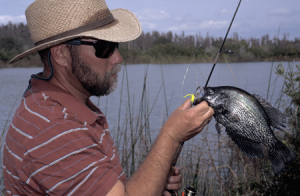Post
Black Crappie Fishing Throughout Florida
Florida Fishing Articles, Regional Fishing, United States Fishing Articles | Florida theangler PM

Crappie are high profile fish with their own professional and amateur enthusiasts. Crappie USA kicked off their 2012 season with an event at Crescent Lake in January. Darrell Van Vactor, President of CrappieUSA, said “The 2.63 pound crappie that won the big fish award on Crescent Lake was definitely a great crappie, in fact after running crappie tournaments all over the state of Florida for over 25 years it is the best single fish ever weighed in, and the winning weight of 14.5 pounds for seven fish was also the best winning weight.” He went on to say “Crescent Lake is truly the best crappie water we have found in your state and your department is evidently doing a great management job there.”
Bass Pro Shops Crappie Master Tournament Trail will have their Florida State Championship in February on the Harris Chain of Lakes around Tavares. Anglers can find books, magazines, web sites and television shows all dedicated to highlighting great crappie fisheries. The fast action, once you have located a school, makes crappie a great fish for families and youth.
 The Florida Fish and Wildlife Conservation Commission (FWC) annually produces a list of top crappie destinations (as well as lists for black bass, bream, catfish and stripers, which are published at MyFWC.com/Fishing, select “Freshwater” then “Sites and Forecasts” for more). This year Cheree Steward (a FWC fisheries biologist in Eustis) helped compile the list.
The Florida Fish and Wildlife Conservation Commission (FWC) annually produces a list of top crappie destinations (as well as lists for black bass, bream, catfish and stripers, which are published at MyFWC.com/Fishing, select “Freshwater” then “Sites and Forecasts” for more). This year Cheree Steward (a FWC fisheries biologist in Eustis) helped compile the list.The list includes:
• Rodman Reservoir (Between Gainesville and Palatka)
• Lake Monroe (Near Sanford; note Crescent lake is north of Lake Monroe on the St. Johns River)
• Lake Talquin (West of Tallahassee)
• Lake Weohyakapka / Walk-in-Water (East of Lake Wales)
• Lake Weir (South Marion County)
• Lake Arbuckle (East of Frostproof)
• Lake Marian (Southeast Osceola County, east of Lake Kissimmee)
• Lake Marion (East of Haines City)
• West Lake Tohopekaliga (South of the city of Kissimmee)
• Lake Kissimmee (East of the city of Lake Wales)
• Mosaic Fish Management Area (Southern Polk County)
• Lake Istokpoga (Near Sebring)
• Lake Trafford (Near Immokalee)
Steward points out that reports from local anglers, and trawls, electrofishing, creels and other data from fisheries biologists, and knowledge of habitat trends all go into selecting these lakes. The list focuses on larger water bodies that have good access and can sustain more fishing effort, so even if your local lake isn’t on the list, don’t be afraid to try it. One of the best things about crappie fishing in Florida is that you can find them in almost all of our lakes.
Unlike most other panfish, crappie spend much of their time offshore, feeding on small fish. Successful anglers often drift through deeper water, fishing with small minnows or freshwater grass shrimp until they find a school. Try a light wire #4 hook and small split shot below a float. Speck anglers typically use several rods or poles, fishing at different depths until they pinpoint concentrations of fish. In the extreme, these are referred to as “spider rigs” for the way the rods look like spider legs sticking out from all sides of the boat. Specks move inshore to spawn during early spring, sometimes gathering in large numbers around heavy cover. Crappie also readily strike artificials; 1/16 oz. to 1/8 oz. feathered or curly-tail jigs in white, yellow, pink and chartreuse are popular. Tipping the jig with a live minnow makes it even more effective. Night fishing for crappie is equally productive. Any of the above baits fished near a lantern or floodlight can produce nice stringers. Most crappie fishing occurs in cooler months, but anglers who fish into the summer can do very well, especially at night.
As with other fish, healthy habitat is the key, and occasional regulation changes can help sustain quality crappie fisheries. For instance, a new regulation is currently being contemplated for Lake Griffin, and the FWC is seeking public opinion. The proposed rule would establish a 10-inch minimum size limit for black crappie from Lake Griffin (there is not a general statewide length limit for crappie) and keep the statewide daily bag limit of 25. Biologists expect implementation of the rule to prevent the current bumper production of big crappie from being over fished and help more anglers to enjoy the fishery for a longer time.

Crappie provide a great fishing opportunity, especially this time of year, and can be an exciting way to introduce new anglers both young and old to the lifetime sport of fishing. Moreover, many anglers think they are one of the tastiest of freshwater fishes, so give them a try.
Instant licenses are available at MyFWC.com/License or by calling 1-888-FISH-FLORIDA (347-4356). Report violators by calling *FWC or #FWC on your cell, or 1888-404-3922. Visit MyFWC.com/Fishing or scr.bi/Fish-busters for more Fish Busters’ columns.
By Bob Wattendorf
